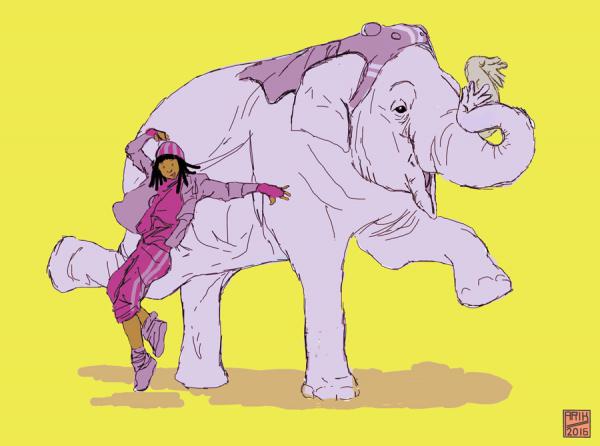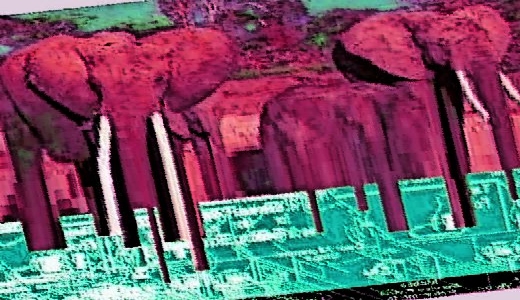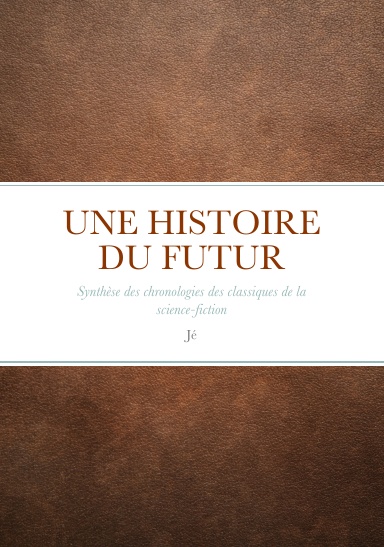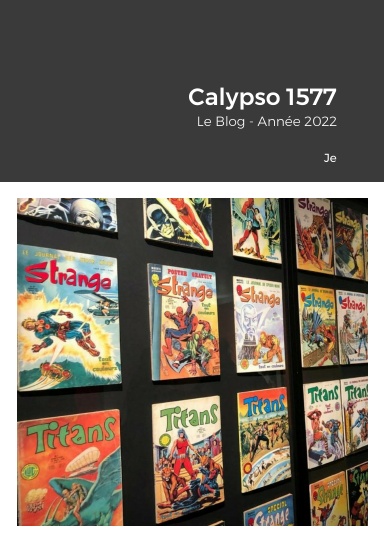Genetically Engineered Sophont Elephants | |

Image from Arik
| |
| Jessi, a nearbaseline human, dancing with Mahotep, a Sufant. | |
A program of genetic engineering of elephants began in the mid-third century AT by a consortium of companies from Sri Lanka and Thailand who wished to improve the working Asian elephants already present in their countries. Already being intelligent, the provolution of elephants did not prove too hard a task, limited mainly by the slow reproductive and generation cycle of the elephant species.
However in 350 A.T. they successfully engineered the 'Superphant', which was more intelligent than an unmodified Asian elephant, with a more dextrous trunk and some limited ability to speak. Superphant was quickly contracted to Sufant, the name all of the various elephant provolve races have been known by ever since.
They were a great success in their jobs, and even came to replace mechanical vehicles in some roles, particularly in rough country. Because of this success, the Sufants spread to other places, particularly India and other south-east-Asian countries. As the success of the project grew, the first Pan-Sophontism movements began to grow up, particularly in Sri Lanka. The Sufants were one of the earlier provolved sophont races, being perhaps the fifth or sixth such race (records are unclear).
Later generations of Sufants were made more intelligent yet, up to the human level, and it was here that problems began to arise. The Sufants tended to still have contact with unmodified elephants in their work, but the more intelligent they became, the less and less well the modified and unmodified elephants got on. The difference in intelligence was simply too great, leading to a number of fatal fights between individuals and small groups of Sufants and normal elephants, with a great deal of collateral damage as these multi-tonne-mass creatures brawled in the street.
To solve this problem, most governments simply decreed that the Sufants and normal elephants be segregated from one another. However, the Sri Lankan government came to a different conclusion. Influenced by the Pan-Sophontism movement growing in their country, they instead decreed that all elephants in Sri Lanka be provolved into Sufants, with the new intelligent species to be given full equality with the humans there.
In time the idea of equality for Sufants spread, and all members of the species everywhere came to be granted citizenship of their various nations, though, in some cases, not without struggle and deaths. But eventually Sufants came to live peacefully side-by-side with humans across Asia, with all of Sri Lanka's elephants now being a sentient race, one more flavour in that nation's cultural melting pot.
As the Sufant race developed, with their permission additional changes were made to them, increasing the dexterity and number of fingers of their trunks, and also increasing the number of trunks, normally to two (sometimes side by side, sometimes one on the top lip of the Sufants, one on the bottom lip), but in a few cases to four, or even six. In all cases efforts were made to ensure that all Sufants remained inter-fertile.
While the Sufant race was spreading in Asia, efforts to provolve African elephants were also being made by a group of African nations led by the government of Kenya. This was inspired by the success of the Sufants, and also revived an old idea as to how useful tame or sentient African elephants could be to the development of the continent.
However, although as intelligent as the Asian variety, African elephants proved a much harder species to provolve. Not only did they not have the thousands of years of association with humanity 'hard-wired' into them which the Asian species possessed, but they also simply did not seem to like humans, regardless of all the efforts made to change this. They seemed, as a race, to hold a grudge against humanity as a whole, perhaps for the long-term hunting of their kind for ivory by humans.
Despite this, a small group of sophont African elephants was produced, and given a reserve on which to live while their future was considered. They came to look down their noses (quite an impressive thing, with an elephant) at the Sufants, considering them far too friendly with humanity. The Sufants, in their turn, and after a number of heated meetings with representatives of the African provolves, also came to look down on the African provolves as ignorant half-savages who should stay on their reserve, and away from humanity.
By the time of the Technocalypse, Sufants were well established across Asia, and in a few other parts of the world too. Experiments in creating lazurogenic mammoths were also taking place, with the intention of, perhaps, creating a cold-adapted Sufant. The small enclave of provolved African elephants also still existed, having been rather ignored, perhaps in the hope that it would simply go away. However, very few provolved elephants of any kind had been into space, mainly because of their size and difficulty of manoeuvring in micro-gravity.
The Technocalypse nearly caused the extinction of all of the various elephant provolve races. It is almost certain that the African provolves did become extinct during the Grey Spring of 541 AT, though they were later recreated by the GAIA archailect. As with all of the other sophonts of Earth, after GAIA took charge the Sufants and African provolves were given the choice of staying on Earth and living in an eco-friendly manner, or leaving. All of the African provolves and a few of the Sufants remained on Earth; most of the Sufants left.
In due course the Technocalypse was overcome and stability returned, and the Sufants diversified even further, some setting up polities of their own, and some living side by side with the other sophont races.
The diversification of the Sufants included the creation of lazurogenic mammoth, mastodon and deinotherium-types, which have all became distinct sub-species, as have a number of pygmy Sufant types. Using bionanotech to strengthen their bones and other tissues also led to some Sufant groups becoming gigantic, the largest Terragen-descended land animals ever to exist. These various original groups of Sufants have since diversified into a number of sub-clades, each containing mixtures of different features such as origin (Asian elephant, Indian elephant or lazurogenic mammoth, mastodon or deinotherium), size, and number of trunks. Some Suphants have also been given a prehensile tail so that they have manipulative ability at both ends of their body. Certain other types of Suphant refer to this sub-group by the derogatory term 'Monkeyphants'.
Almost all elephants and Sufants have a unique seismic sense, the ability to both receive and transmit infrasonic seismic signals through the ground, allowing them to sense activity, and communicate with other Sufants and elephants at great distances. They can also use their seismic sense to detect vibrations and so on in objects they touch.
None of the elephant provolves proved to particularly like living on starships or in space habitats, apparently because of the limitations such places put on their seismic sense, and the impression they gain from this sense of their living over a great void. Because of this, the only large elephant provolve settlements grew up on planetary surfaces.
Some space-going Sufant groups did have their seismic sense removed to make their lives there easier. Most other Sufants look down on them much as a human might on someone who voluntarily plucked out their own eyes. Other space-going groups have simply adjusted their brains so they do not react so negatively to what their seismic sense detects in space. Some space-going Sufants have also adjusted themselves to existence in microgravity, with prehensile feet and so on; many of these now do not greatly resemble baseline elephants.
It was some time after the Gaian Whales left Earth that a similar Diaspora of Earth-based elephant provolves began. These proved to consist entirely of African elephant provolves, who wanted nothing to do with any other race. Their ships departed into interstellar space after only minimal contact with anyone else. A few of these provolves settled on the world Hhrraiirah in Sophic League space, but most of them are still heading to rimward, presumably hoping to escape the Terragen Sphere altogether.
In the millennia since, the Sufants have spread far and wide through Terragens space. Expansion into space has occasionally brought various Terragens-descended groups into contact with African-descended Sufant groups who have settled on various previously unexplored worlds. These groups usually pack up and leave when outsiders make contact with them. Because of this behaviour it is suspected that there are also a number of Hider Sufant groups. African Sufant polities have, on a number of occasions, warred with human and other groups, particularly Indian-descended Sufants (who they disparagingly refer to as 'Baba's, after an ancient fable), apparently still bearing their ancient grudge.
There have been, and are, a number of Sufant polities spread across Terragens space. Most of these are fairly small in influence, partly because their large size tends to lead to their worlds having small populations (a maximum of hundreds of millions on an Earth-like world, with little room for other large herbivores) and also because they tend to be limited to large savannah, forest or tundra-type habitats. Because of their seismic sense, few Sufant polities use space habitats of any kind, and what space vessels they have tend to be very solid hollowed out of asteroids with living quarters installed inside. However, a few Sufant groups are spacefaring and a number are heavily cyborged and bioborged. Many Sufant ships have seismic communication systems.

Image from Steve Bowers
|
One of the most successful of the Sufant sub-clades is the Harrroh descended from Indian elephants, who are respected as philosophers, playwrights and artists. However, there are many other clades of sufant which are found throughout the Terragen Sphere.
The Hhrraiirah, in the Sophic League, are descended from the African elephants who left Earth later, and have established a quite competitive culture that puts them rather at odds with most of the rest of the League.
Many Sufant groups have world-deity-based religious beliefs based on their seismic sense, which, to them, allows the world talk to them, and the world allows them to talk to others at great distances. Those Sufant groups who are non-technological and/or primitive (whether from choice or otherwise) often take these beliefs much more seriously than high-technology groups. Some Sufant worlds have implemented computer networks, and in particular BioGeoComputer systems, such that it and they can communicate via the ground, using their seismic sense.
The various Sufant races have also, over time, produced their share of higher toposophic entities.
Unmodified elephants walk at a pace of perhaps four miles per hour, but can charge at speeds of up to thirty miles per hour. They cannot jump and so cannot pass barriers too wide or too high to step over, but they can swim well. They are surprisingly graceful, and can be remarkably stealthy for such large creatures. All of these capabilities are retained in most Sufants.
The social structure of Prim and Ludd Sufant groups is often not unlike those of unmodified elephants. Male and female Sufants in such societies tend to live in separate groups (herds).
The female herd is the much more enduring social group, and is the basis of Sufant society. These herds (which also include any children) are led by a matriarch, the 'keeper of the memory', the oldest and most experienced of the herd, who guides the herd - her family, generally consisting of her female offspring and their young, though it can also include one of the matriarch's sisters and her offspring as well - and protects them from danger, using the wisdom she has acquired over the years. These groups tend to be between ten and twenty individuals, but can split up pr merge depending on the size of the family, the amount of available food, and how well they are getting along. Female groups that split up maintain contact with one another, forming a wider society, and with links to other groups form clans, which are even larger social units.
When the matriarch of a herd dies or otherwise steps down from her position, one of the oldest of her offspring takes her place. Without leadership unmodified elephants become unhappy and disorientated; although Sufants can cope better with this, they are still uncomfortable if they are in a leaderless group. However, because they are sophont they normally have a defined line of succession so that, even if medical treatment is not available, it would take a major disaster to render a herd entirely leaderless.
Male (bachelor) herds tend to be much more nomadic and transitory than the female herds. As male Sufants grow older and approach puberty they gradually become more independent from the family group, spending more time on its outskirts. Eventually, the males leave the family and join with other males of different ages in a bachelor herd.
In general the male and female herds remain apart, only coming together when females are in heat, when a male will pursue a female until she accepts him (or chases him off), mate, and then return to the bachelor herd.
More advanced Sufants will have societies which are based on this social structure, but usually have a thick layer of civilisation overlaying the basic society making it, in many cases, barely recognisable as deriving from baseline elephant society. And with the diversification of the Sufant clade into a superclade there are now, as with all superclades, countless different tribes, subclades, species, cultures, lineages, and so on which vary greatly among themselves in social and other matters.
In many advanced Sufant societies herd leadership is provided by AIs, or by Sufants who have ascended to higher toposophic levels. In some cases this has also allowed the creation of 'super-herds' where one AI or post-Sufant leads not just one herd but many, co-ordinating them together into a very well organised Sufant polity. In other cases, biont-friendly hyperturings have adopted Sufants, and even entire worlds of Sufants, in the same way as they have been known to do with hu and other bionts. On a few worlds the use of implanted communications and web nodes has led to Sufant herds self-organising, not into a group mind (though that has happened in some cases) but into larger and larger clans and beyond this into a society which, although still made up of individuals, acts almost automatically as a single social unit, co-ordinated by their communications web.
All Sufants have an even longer period of childhood than unmodified elephants, becoming sexually mature at around sixteen years of age, and are usually considered fully mature when the male Sufants join the bachelor herds, usually at around twenty-five years of age.
Sufant greetings can be very loud and raucous affairs, as the Sufants, with their heads held high and ears flapping, fill the air with a symphony of trumpets, rumbles, screams, and roars. They take play, joy and grief very seriously.
One thing that has become clear over the centuries is that Sufants have long memories, and they bear a grudge. This was even observed in unmodified African elephants, which have been known to hunt down and kill lion cubs when lions kill their young. Although they are aware that not all of a given group will necessarily be responsible for a given act against them, they will do their best to track down those who act against them, and both gain retribution and ensure that such acts do not happen again. They will not act precipitously in this, but they will, eventually, act. There are several recorded instances of Sufants transcending simply to give them the power to act against some threat to them or their world, and even more of Sufants carrying vendettas over many generations.
Most baseline Sufants also seem to have a near-instinctive negative reaction to big cats, which also applies to provolves, rianths, and splices with big cat characteristics. Those Sufants who have not had this outmoded behaviour edited out of their minds usually have rather strained diplomatic relations with these various cat-like races.
Source : http://www.orionsarm.com/eg-article/47f6d64d4d6bd


















2 commentaires:
Hhrraiirah
Elephant Provolve World
Star: YTS 187-009-1711
Type: G0 V
Luminosity: 2,2 x Sol
Distance from Sol: 1981 ly
Constellation: Puppis
Colonised: 5533 AT
(Sophic League) The home of the Hrruuaiih Sufant clade, developed from African elephants. Hhrraiirah is a terraformed ex-Venusian type world of 0.85G, and covered in verdant savanna, with large biocities clustered along the equatorial region of the main continent Hrriiihhhhauahh.
A number of other sapient species live on the surface and in orbitals, but most of the political power is entrenched in Hrruuaiihian hands (or trunks, as the case may be). Most of the other worlds in the system have been terraformed or paraterraformed, and each has its own uplift species. The system is serviced by a single medium-gauge wormhole.
Harrroh
One of the most respected species of sufants, originally descended from Indian elephants. Most live on the terraformed planets of Yhrraini and Jhairrn in the (Utopia Sphere). They are widely admired as philosophers, playwrights, and artists.
Enregistrer un commentaire